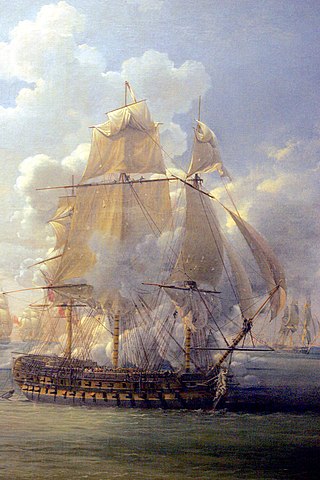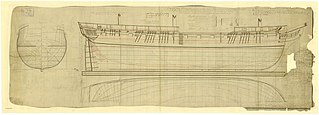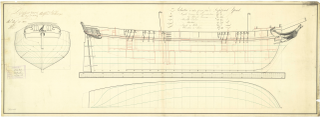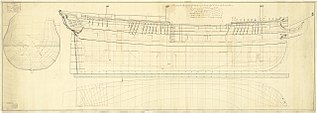
Didon was a Virginie-class 40-gun frigate of the French Navy. Captured by the British in 1805, she went on to serve briefly in the Royal Navy as the 38-gun fifth-rate HMS Didon until she was sold in 1810.
HMS Lively was a 38-gun fifth rate frigate of the Royal Navy, launched on 23 July 1804 at Woolwich Dockyard, and commissioned later that month. She was the prototype of the Lively class of 18-pounder frigates, designed by the Surveyor of the Navy, Sir William Rule. It was probably the most successful British frigate design of the Napoleonic Wars, to which fifteen more sister ships would be ordered between 1803 and 1812.

HMS Hercule was a 74-gun third rate ship of the line of the Royal Navy. She was previously Hercule, a Téméraire class ship of the line of the French Navy, but was captured on her maiden voyage in 1798, and spent the rest of her career as a British ship. She was broken up in 1810.
Mignonne was an 18-gun Etna-class corvette of the French Navy, launched in 1795. She served until 1803 when the British captured her. Though she served briefly, there is no record of her actually being commissioned into the Royal Navy; she grounded and was condemned in 1804.
Diane was a 38-gun frigate of the French Navy, launched in 1796. She participated in the battle of the Nile, but in August 1800 the Royal Navy captured her. She was taken into British service as HMS Niobe, and broken up in 1816.

HMS Amphion was a 32-gun fifth rate frigate, the lead ship of her class, built for the Royal Navy during the 1790s. She served during the Napoleonic Wars.

HMS Galatea was an Apollo-class fifth rate of the Royal Navy. The frigate was built at Deptford Dockyard, London, England and launched on 31 August 1810. In 1811 she participated in the Battle of Tamatave, which battle confirmed British dominance of the seas east of the Cape of Good Hope for the rest of the Napoleonic Wars. She was hulked in 1836 and broken up in 1849.

HMS Decade was a 36-gun fifth-rate frigate of the Royal Navy. She was formerly the French 'Galathée-class frigateDécade, which the British had captured in 1798. She served with the British during the French Revolutionary and Napoleonic Wars, and was sold out of the service in 1811.

Palinure was the nameship for the Palinure-class of 16-gun brigs of the French Navy, and was launched in 1804. In French service she captured Carnation before Circe captured her in turn. After being taken into the Royal Navy as HMS Snap, she participated in two campaigns that qualified her crew for the Naval General Service Medal (NGSM). She was broken up in 1811.
The 16-gun French Mutine-class corvette Aurore was launched in 1799. The British frigate HMS Thames captured her in 1801; she was commissioned into the Royal Navy in 1803 and named HMS Charwell. Charwell served in the Channel, South Atlantic, and Indian Ocean. She was laid up in 1810 and sold in 1813.

Faune was a French naval Abeille-class brig-corvette launched in 1804 to a design by François Pestel in 1803. She participated in the capture of HMS Blanche in July 1805. The Royal Navy captured Faune in August 1805. She was taken into service as HMS Fawn, but the last record of her dates to 1806. In 1807 the Royal Navy launched a new HMS Fawn.

Vertu was a 40-gun French frigate designed by engineer Segondat. She served in Sercey's squadron in the Indian Ocean, and in Saint-Domingue. She was captured by the Royal Navy at the end of the Blockade of Saint-Domingue when the island surrendered to the British. After her capture the Navy sailed her to Britain but never commissioned her, and finally sold her in 1810.

The French brig Néarque was an Abeille-class brig launched at Lorient in 1804. She made a voyage to the Caribbean in 1805. After the frigate HMS Niobe captured her in March 1806, the Royal Navy took her into Plymouth, but laid her up in ordinary. She then disappears from the records until her sale in 1814.
The French schooner Découverte was a French Navy vessel launched in 1800. The British captured her at Santo Domingo in 1803 and took her into service as HMS Decouverte. She was decommissioned in January 1806 and sold in 1808.
HMS Cerf was the Spanish Navy's 18-gun brig Cuervo, built at Havana in 1794-95. A British privateer captured her and her captors renamed her Stag before in December 1801 selling her to the Captain-General of Guadeloupe. The French Navy took her into service as the 14-gun brig Cerf. The Royal Navy acquired Cerf at the surrender of Santo Domingo on 30 November 1803. The Royal Navy sold her in 1806.
The French brig Observateur, which was launched in 1800 for the French Navy, was a Vigilant-class 16-gun brig, one of six built to a design by Pierre-Alexandre-Laurent Forfait. The Royal Navy captured her in 1806 and took her into service as HMS Observateur. She participated in two actions, one for the French Navy and one for the Royal Navy, and one campaign before she was laid up in 1810. The Navy did not succeed in selling her until 1814.
The French brig Colombe was launched in 1795 for the French Navy. She had a minor role in the mutiny on HMS Danae. The British captured her in 1803. She never served on active duty in the Royal Navy but instead was immediately laid-up. She was broken up in 1811.
His Majesty's Hired armed cutter Sandwich served the Royal Navy from 23 May 1798 until the French frigate Créole captured her on 14 June 1799. She then served in the French Navy until the Royal Navy recaptured her on 15 October 1803. The Navy purchased her in 1804 and she served for some months in 1805 as HMS Sandwich before she was sold in Jamaica. During this period she captured three small French privateers in two days.

Milan was a French brig built at Saint Malo, from plans designed by François Pestel that had already served for Curieux in 1800 and for Palinure in 1804. She served in the French Navy for four years before HMS Surveillante and Seine captured her. She became HMS Achates in the Royal Navy and served until after the end of the Napoleonic Wars.

HMS Chichester was a two-deck, fifth-rate ship of the Royal Navy. One of the Adventure-class ships designed by Edward Hunt, she was built to carry 44 guns but for her entire career she served as a troopship, never carrying more than 22. In 1803, she was part of the squadron under Samuel Hood that captured the French held islands of St Lucia and Tobago, and the Dutch colonies of Demerara, Essequibo and Berbice.










